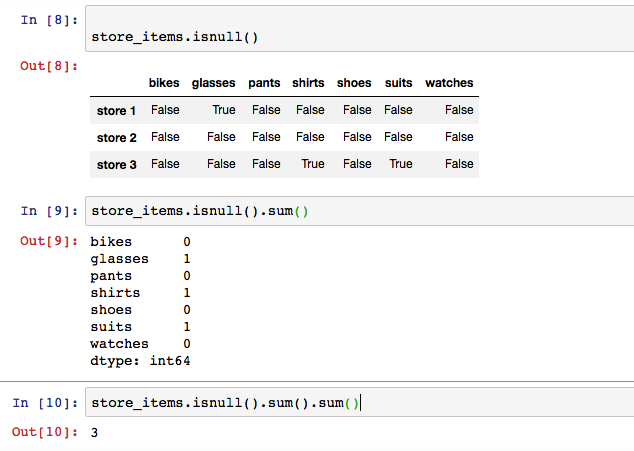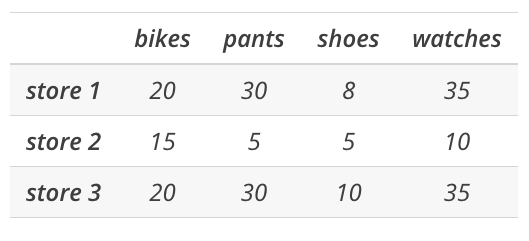Python Pandas DataFrame 处理 NaN (二十二)
正如之前提到的,在能够使用大型数据集训练学习算法之前,我们通常需要先清理数据。也就是说,我们需要通过某个方法检测并更正数据中的错误。虽然任何给定数据集可能会出现各种糟糕的数据,例如离群值或不正确的值,但是我们几乎始终会遇到的糟糕数据类型是缺少值。正如之前看到的,Pandas 会为缺少的值分配 NaN 值。在这节课,我们将学习如何检测和处理 NaN 值。
首先,我们将创建一个具有一些 NaN 值的 DataFrame。
# We create a list of Python dictionaries
items2 = [{'bikes': 20, 'pants': 30, 'watches': 35, 'shirts': 15, 'shoes':8, 'suits':45},
{'watches': 10, 'glasses': 50, 'bikes': 15, 'pants':5, 'shirts': 2, 'shoes':5, 'suits':7},
{'bikes': 20, 'pants': 30, 'watches': 35, 'glasses': 4, 'shoes':10}]
# We create a DataFrame and provide the row index
store_items = pd.DataFrame(items2, index = ['store 1', 'store 2', 'store 3'])
# We display the DataFrame
store_items
可以清晰地看出,我们创建的 DataFrame 具有 3 个 NaN 值:商店 1 中有一个,商店 3 中有两个。但是,如果我们向 DataFrame 中加载非常庞大的数据集,可能有数百万条数据,那么就不太容易直观地发现 NaN 值的数量。对于这些情形,我们结合使用多种方法来计算数据中的 NaN 值的数量。以下示例同时使用了 .isnull()和 sum()方法来计算我们的 DataFrame 中的 NaN 值的数量。
# We count the number of NaN values in store_items
x = store_items.isnull().sum().sum()
# We print x
print('Number of NaN values in our DataFrame:', x)
Number of NaN values in our DataFrame: 3在上述示例中,.isnull()方法返回一个大小和 store_items 一样的布尔型 DataFrame,并用 True 表示具有 NaN 值的元素,用 False 表示非 NaN 值的元素。我们来看一个示例:
store_items.isnull()
在 Pandas 中,逻辑值 True 的数字值是 1,逻辑值 False 的数字值是 0。因此,我们可以通过数逻辑值 True 的数量数出 NaN 值的数量。为了数逻辑值 True 的总数,我们使用 .sum() 方法两次。要使用该方法两次,是因为第一个 sum() 返回一个 Pandas Series,其中存储了列上的逻辑值 True 的总数,如下所示:
store_items.isnull().sum()打印:
bikes 0
glasses 1
pants 0
shirts 1
shoes 0
suits 1
watches 0
dtype: int64第二个sum()将上述 Pandas Series 中的 1 相加。
除了数 NaN 值的数量之外,我们还可以采用相反的方式,我们可以数非 NaN 值的数量。为此,我们可以使用 .count() 方法,如下所示:
# We print the number of non-NaN values in our DataFrame
print()
print('Number of non-NaN values in the columns of our DataFrame:\n', store_items.count())打印
Number of non-NaN values in the columns of our DataFrame:
bikes 3
glasses 2
pants 3
shirts 2
shoes 3
suits 2
watches 3
dtype: int64处理NaN
现在我们已经知道如何判断数据集中是否有任何 NaN 值,下一步是决定如何处理这些 NaN 值。通常,我们有两种选择,可以删除或替换 NaN 值。在下面的示例中,我们将介绍这两种方式。
首先,我们将学习如何从 DataFrame 中删除包含任何 NaN 值的行或列。如果 axis = 0,.dropna(axis) 方法将删除包含 NaN 值的任何行,如果 axis = 1,.dropna(axis)方法将删除包含 NaN 值的任何列。我们来看一些示例:
# We drop any rows with NaN values
store_items.dropna(axis = 0)

删除列
# We drop any columns with NaN values
store_items.dropna(axis = 1)
注意,.dropna()方法不在原地地删除具有 NaN 值的行或列。也就是说,原始 DataFrame 不会改变。你始终可以在 dropna() 方法中将关键字 inplace 设为 True,在原地删除目标行或列。
替换fillna()
现在,我们不再删除 NaN 值,而是将它们替换为合适的值。例如,我们可以选择将所有 NaN 值替换为 0。为此,我们可以使用.fillna()方法,如下所示。
# We replace all NaN values with 0
store_items.fillna(0)
我们还可以使用 .fillna() 方法将 NaN 值替换为 DataFrame 中的上个值,称之为前向填充。在通过前向填充替换 NaN 值时,我们可以使用列或行中的上个值。.fillna(method = 'ffill', axis)将通过前向填充 (ffill)方法沿着给定 axis使用上个已知值替换 NaN 值。我们来看一些示例:
# We replace NaN values with the previous value in the column
store_items.fillna(method = 'ffill', axis = 0)
注意 store 3 中的两个 NaN 值被替换成了它们所在列中的上个值。但是注意, store 1 中的 NaN 值没有被替换掉。因为这列前面没有值,因为 NaN 值是该列的第一个值。但是,如果使用上个行值进行前向填充,则不会发生这种情况。我们来看看具体情形:
# We replace NaN values with the previous value in the row
store_items.fillna(method = 'ffill', axis = 1)
我们看到,在这种情形下,所有NaN 值都被替换成了之前的行值。
同样,你可以选择用 DataFrame 中之后的值替换 NaN 值,称之为后向填充。.fillna(method = 'backfill', axis)将通过后向填充 (backfill) 方法沿着给定 axis 使用下个已知值替换 NaN 值。和前向填充一样,我们可以选择使用行值或列值。我们来看一些示例:
注意,store 1 中的 NaN 值被替换成了它所在列的下个值。但是注意,store 3 中的两个 NaN 值没有被替换掉。因为这些列中没有下个值,这些 NaN 值是这些列中的最后一个值。但是,如果使用下个行值进行后向填充,则不会发生这种情况。我们来看看具体情形:
# We replace NaN values with the next value in the row
store_items.fillna(method = 'backfill', axis = 1)注意,.fillna()方法不在原地地替换(填充)NaN 值。也就是说,原始 DataFrame 不会改变。你始终可以在 fillna() 函数中将关键字 inplace 设为 True,在原地替换 NaN 值。
我们还可以选择使用不同的插值方法替换 NaN 值。例如,.interpolate(method = 'linear', axis)方法将通过 linear 插值使用沿着给定 axis 的值替换 NaN 值。我们来看一些示例:
# We replace NaN values by using linear interpolation using column values
store_items.interpolate(method = 'linear', axis = 0)
注意,store 3 中的两个 NaN 值被替换成了线性插值。但是注意,store 1 中的 NaN 值没有被替换掉。因为该 NaN 值是该列中的第一个值,因为它前面没有数据,因此插值函数无法计算值。现在,我们使用行值插入值:
# We replace NaN values by using linear interpolation using row values
store_items.interpolate(method = 'linear', axis = 1)和我们看到的其他方法一样,.interpolate() 方法不在原地地替换 NaN 值。
小测试
import pandas as pd
import numpy as np
# Since we will be working with ratings, we will set the precision of our
# dataframes to one decimal place.
pd.set_option('precision', 1)
# Create a Pandas DataFrame that contains the ratings some users have given to a
# series of books. The ratings given are in the range from 1 to 5, with 5 being
# the best score. The names of the books, the authors, and the ratings of each user
# are given below:
books = pd.Series(data = ['Great Expectations', 'Of Mice and Men', 'Romeo and Juliet', 'The Time Machine', 'Alice in Wonderland' ])
authors = pd.Series(data = ['Charles Dickens', 'John Steinbeck', 'William Shakespeare', ' H. G. Wells', 'Lewis Carroll' ])
user_1 = pd.Series(data = [3.2, np.nan ,2.5])
user_2 = pd.Series(data = [5., 1.3, 4.0, 3.8])
user_3 = pd.Series(data = [2.0, 2.3, np.nan, 4])
user_4 = pd.Series(data = [4, 3.5, 4, 5, 4.2])
# Users that have np.nan values means that the user has not yet rated that book.
# Use the data above to create a Pandas DataFrame that has the following column
# labels: 'Author', 'Book Title', 'User 1', 'User 2', 'User 3', 'User 4'. Let Pandas
# automatically assign numerical row indices to the DataFrame.
# Create a dictionary with the data given above
dat = dat = {'Book Title' : books,
'Author' : authors,
'User 1' : user_1,
'User 2' : user_2,
'User 3' : user_3,
'User 4' : user_4}
# Use the dictionary to create a Pandas DataFrame
book_ratings = pd.DataFrame(dat)
# If you created the dictionary correctly you should have a Pandas DataFrame
# that has column labels: 'Author', 'Book Title', 'User 1', 'User 2', 'User 3',
# 'User 4' and row indices 0 through 4.
# Now replace all the NaN values in your DataFrame with the average rating in
# each column. Replace the NaN values in place. HINT: you can use the fillna()
# function with the keyword inplace = True, to do this. Write your code below:
book_ratings.fillna(book_ratings.mean(), inplace = True)
打印:
Printing Book Ratings
The correct answer is
Author Book Title User 1 User 2 User 3 User 4
0 Charles Dickens Great Expectations 3.2 5.0 2.0 4.0
1 John Steinbeck Of Mice and Men 2.9 1.3 2.3 3.5
2 William Shakespeare Romeo and Juliet 2.5 4.0 2.8 4.0
3 H. G. Wells The Time Machine 2.9 3.8 4.0 5.0
4 Lewis Carroll Alice in Wonderland 2.9 3.5 2.8 4.2
And your code returned
Author Book Title User 1 User 2 User 3 User 4
0 Charles Dickens Great Expectations 3.2 5.0 2.0 4.0
1 John Steinbeck Of Mice and Men 2.9 1.3 2.3 3.5
2 William Shakespeare Romeo and Juliet 2.5 4.0 2.8 4.0
3 H. G. Wells The Time Machine 2.9 3.8 4.0 5.0
4 Lewis Carroll Alice in Wonderland 2.9 3.5 2.8 4.2
Correct!为者常成,行者常至
自由转载-非商用-非衍生-保持署名(创意共享3.0许可证)



